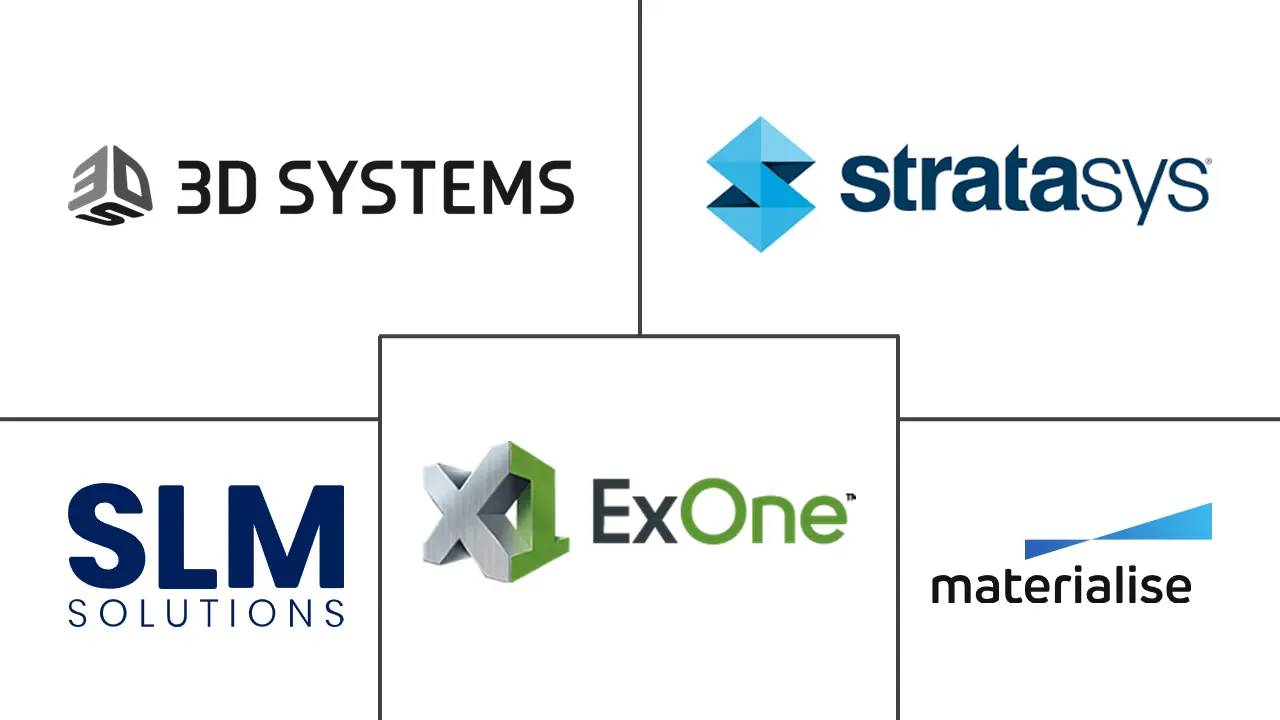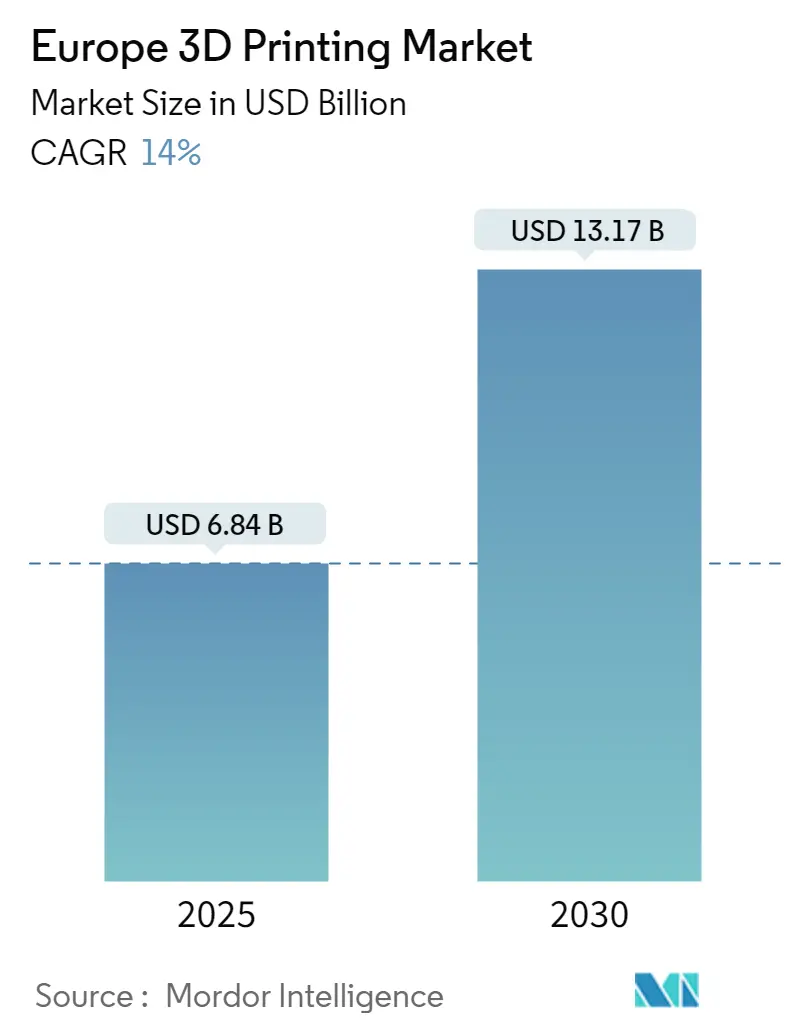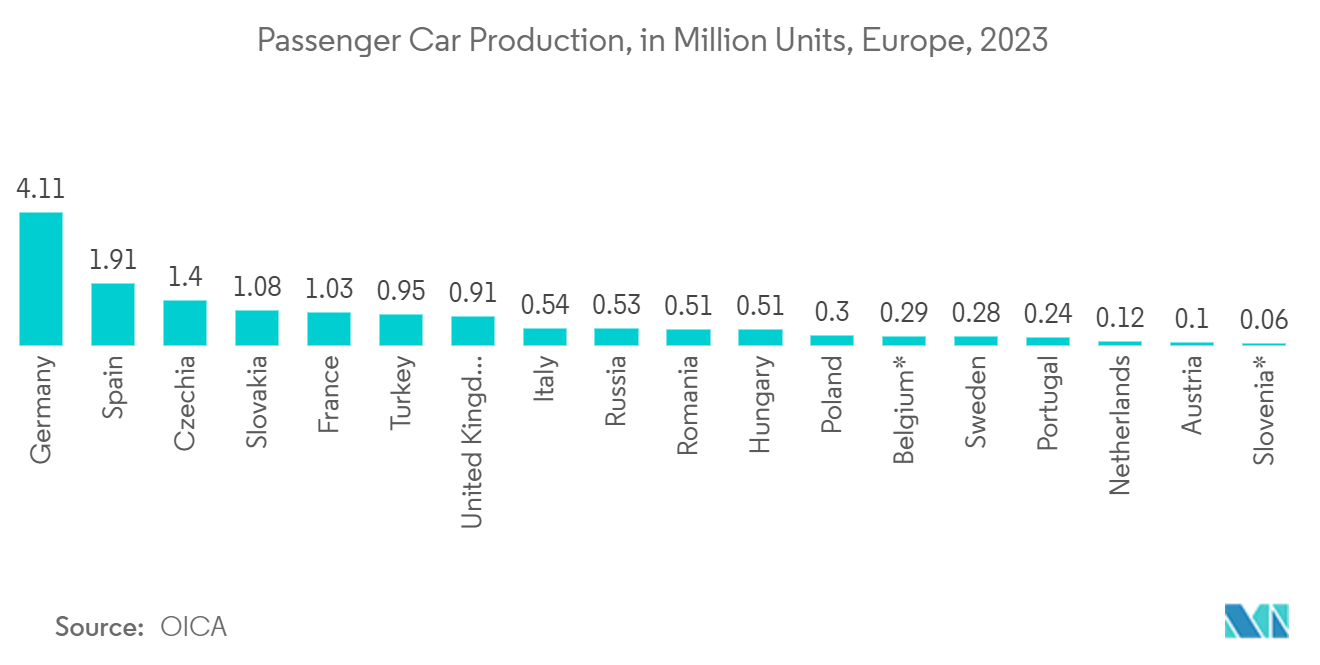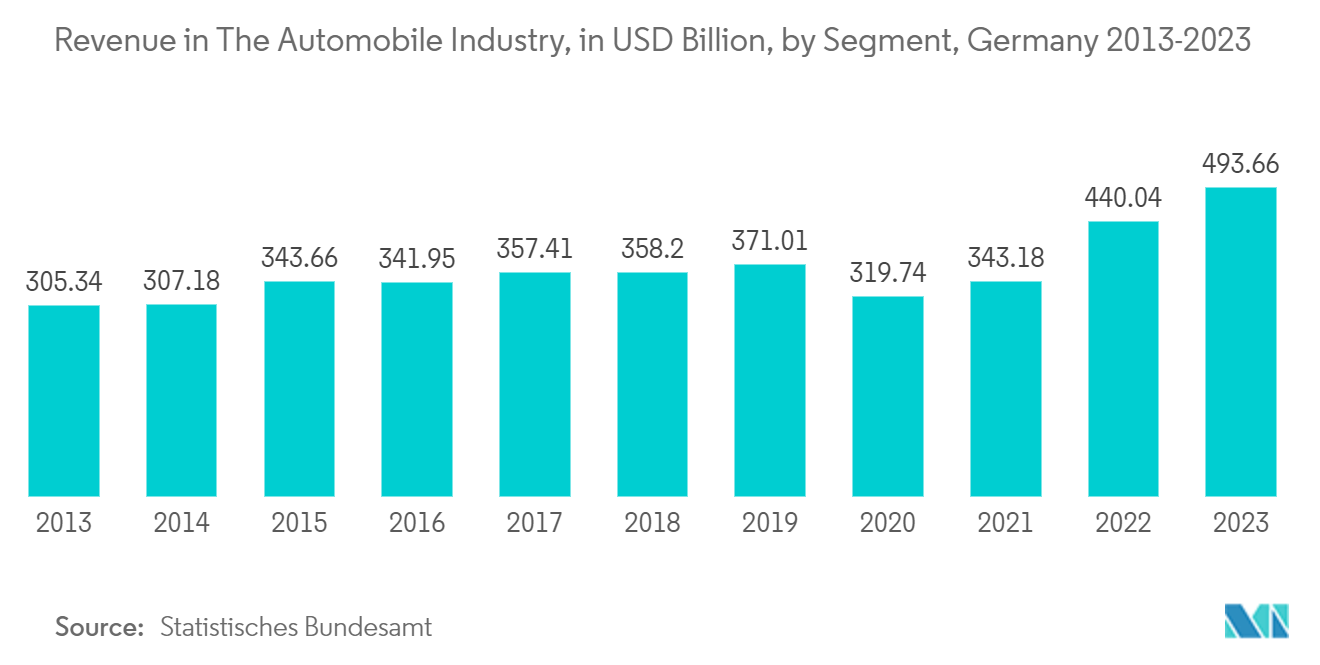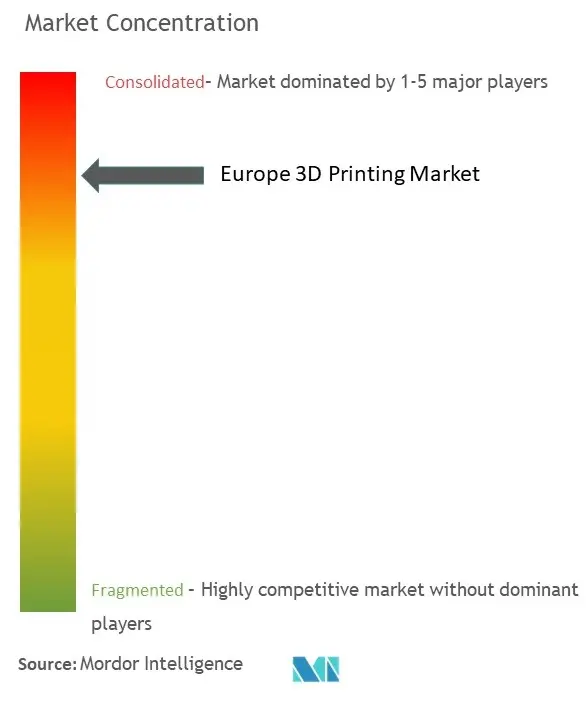Europe 3D Printing Market Analysis
The Europe 3D Printing Market size is estimated at USD 6.84 billion in 2025, and is expected to reach USD 13.17 billion by 2030, at a CAGR of 14% during the forecast period (2025-2030).
Europe is a major hub for 3D printing technology. In Europe, the majority of demand is coming from SMEs that need high-speed, robust, and reasonably priced prototypes.
- The use of 3D printing technology will radically disrupt conventional production in many sectors, as it is capable of delivering differentiated products and solutions at a lower cost. This technology is taking the lead in Europe, thanks to initiatives and spending of governments, opportunities for offering customized products through 3D printing, increased efficiency as well and higher product quality.
- The increase in the rate of adoption of 3D printing technology in various application segments, such as industrial products, aerospace, automotive, defense, healthcare, education & research, are facilitating the growth of the 3D printing market.
- However, the significant barrier to implementing 3D printing technology has been identified as expensive initial costs. This expenditure includes software, hardware, materials, additive and manufacturing expertise, certification, and worker training. The cash and manpower necessary to build a three-dimensional system are significantly more than those needed for standard printing technologies. However, with the commercial desktop 3D printer launch, companies are assisting end-customers in lowering the expensive initial expenses.
- The significant penetration of 3D printing technology was observed in important industry segments like health and aeronautics, where growth is increasing at a promising rate. 3D printing is helping to create more efficient processes in the aerospace sector; aircraft manufacturers have invested billions in developing the use of metal powders through this technology to make turbine blades, jet engine combustion nozzles, and structural parts.
- Nonetheless, some of the major factors inhibiting market growth include lack of standard process control and limited availability or significant costs in terms of 3D printing materials.
Europe 3D Printing Market Trends
High Adoption of 3D Prototype Parts in Automotive Industry
- The European automotive sector has been thriving and has emerged as a pioneer and driving force behind the country’s development and wealth. In past years, the European automotive sector has risen to the forefront of the global industry.
- With the presence of many global automotive OEMs, Europe enjoys the broad-scale implementation of 3D printing technology for design formulation and R&D applications in the automotive industry. Top automotive leaders such as BMW, Mercedes, Audi, Jaguar Land Rover, Volkswagen, and many others have created a potential space for 3D technology and printers in the European market.
- According to OICA, in 2023, Germany produced the most significant passenger cars in Europe, 4.11 million. Spain ranked second, with almost 1.91 million passenger cars produced.
- In April 2022, Blackstone Technology formulated a plan to market 3D-printed sodium-ion cells for electric cars. The business plans to launch its 3D-printed solid-state battery in the middle of the decade after investing EUR 32 million (USD 33,900,531.60 Million) in a prototype facility in Döbeln, Germany. The solid-state batteries would first be put in the electric buses in Berlin to be tested in a real-world scenario.
- Moreover, several 3D printing methods are employed to manufacture prototypes with rapid turnaround times at Ford's Rapid Technologies Center in Merkenich, Germany. Instead of sending a task out to a business with a several-week lead time, engineers and designers can have their designs in their hands within hours. Designers can create same-day prototypes in the Rapid Technology Center, iterating on numerous designs in a matter of hours. According to Bruno Alves, an additive manufacturing expert at Ford, physical prototypes can have advantages over digital models.
Germany is Expected to Hold the Major Share
- A wide range of established industry players, including EOS, Renishaw, SLM Solutions, Ultimaker, and Photocentric, are well-known throughout Europe for their technical expertise in the field of additive manufacturing. The majority of 3D printers are located in Western Europe, with countries such as Germany, the United Kingdom, Italy, and France driving AM development and applications.
- Moreover, increasing investments in the market studied by various countries in the region may further create significant demand. According to GTAI (Germany Trade & Investment), Germany is home to some of Europe's most advanced 3D printing and additive manufacturing businesses, including aerospace, automotive, equipment, and dentistry.
- According to Statistisches Bundesamt, in 2023, the German automobile industry generated revenues of EUR 457.6 billion (USD 493.6 billion) in the motor vehicles segment, an increase from the previous year.
- One in every three big German industrial companies already uses 3D printing, and two out of every three have already used the technology. This, in turn, may create lucrative opportunities for the market players to expand their footprint in the country, thus boosting market growth.
- For instance, in December 2022, HeadmadeMaterials, a German 3D printing technology provider, intended to enter the ColdMetalFusionAlliance and other significant market players. ColdMetalFusion is a partnership of industry leaders with generations of sintering, additive manufacturing, and traditional industrial production experience. Partners of the Alliance collaborate to provide services, materials, equipment, and technology to clients in the metal production business.
Europe 3D Printing Industry Overview
Though the presence of many regional as well as global players in the European region is influencing the 3D printing market, the major chunk of the European market is captured by prominent players. Hence, the market for 3D printing is expected to be consolidated in nature. 3D Systems Corporation, Materialise NV, Stratasys Ltd., ExOne Co., and SLM Solutions Group AG, among others, are some major players in the European market. All these players are involved in competitive strategic developments such as acquisition, partnership, new product development, and market expansion to augment their leadership position in the European 3D printing market.
In October 2022, Safran opened a new additive manufacturing campus in France. Safran's new 12,500 m2 facility houses all the procedures required to create parts utilizing additive manufacturing, from R&D through engineering and production. With cutting-edge equipment, including 3D printers that employ 3D digital images to transform metallic powders into airplane and engine parts, more than 100 top-tier engineers, scientists, and technicians are currently operating at the factory to make components for the whole team.
In July 2022, a European automobile company installed metal 3D printers from SLM Solutions. The customer has over ten machines in its 3D printing fleet, including many SLM 500 and SLM 250 systems. It is believed to be using metal AM to build car elements, emphasizing serial manufacturing.
Europe 3D Printing Market Leaders
-
Materialise NV
-
SLM Solutions Group AG
-
Stratasys Ltd.
-
3D Systems Corporation
-
ExOne Co.
- *Disclaimer: Major Players sorted in no particular order
Europe 3D Printing Market News
- April 2023: Stratasys Ltd., a company at the forefront of polymer 3D printing solutions, has announced that it has successfully acquired Covestro AG's additive manufacturing materials business (DAX: 1COV). The purchase includes R&D facilities, global development and sales teams in the US, Europe, and Asia, a collection of nearly 60 additive manufacturing materials, and a large intellectual property portfolio of hundreds of patents and pending patents. The acquisition will be immediately accretive.
- January 2023: Nikon, a Japanese company specializing in optics and imaging, has officially overtaken SLM Solutions, a German manufacturer of metal 3D printers. The acquisition was agreed upon last year and saw Nikon acquire all of SLM Solutions' shares at EUR 20 per share, totaling EUR 622 million (USD 65,63 million). Toshikazu Umatate, the CEO of Nikon, believes that this acquisition will enable both companies to offer their customers in different sectors of the world a more complete and rapid solution.
Europe 3D Printing Industry Segmentation
3D printing, also known as additive manufacturing, creates a three-dimensional product from a CAD design or a computer 3D model. It can be accomplished using several techniques, whereby a substance is deposited, connected, or solidified beneath computerized control, often layer by layer.
The European 3D printing market is segmented by component (hardware, services), technology (steel lithography (SLA), fused deposition modeling (FDM), electron beam melting, digital light processing, selective laser sintering (SLS), end-user industry (automotive, aerospace, and defense), healthcare, construction and architecture, energy, and food), and country (Germany, the United Kingdom, France, Italy, Spain, the Netherlands, and the rest of Europe).
The market sizes and forecasts are provided in terms of value in USD for all the above segments.
| By Component | Hardware |
| Services | |
| By Technology | Stereo Lithography (SLA) |
| Fused Deposition Modeling (FDM) | |
| Electron Beam Melting | |
| Digital Light Processing | |
| Selective Laser Sintering (SLS) | |
| Other Technologies | |
| By End-user Industry | Automotive |
| Aerospace and Defense | |
| Healthcare | |
| Construction and Architecture | |
| Energy | |
| Food | |
| Other End-user Industries | |
| By Country | Germany |
| United Kingdom | |
| France | |
| Italy | |
| Spain | |
| Netherlands |
Europe 3D Printing Market Research Faqs
How big is the Europe 3D Printing Market?
The Europe 3D Printing Market size is expected to reach USD 6.84 billion in 2025 and grow at a CAGR of 14% to reach USD 13.17 billion by 2030.
What is the current Europe 3D Printing Market size?
In 2025, the Europe 3D Printing Market size is expected to reach USD 6.84 billion.
Who are the key players in Europe 3D Printing Market?
Materialise NV, SLM Solutions Group AG, Stratasys Ltd., 3D Systems Corporation and ExOne Co. are the major companies operating in the Europe 3D Printing Market.
What years does this Europe 3D Printing Market cover, and what was the market size in 2024?
In 2024, the Europe 3D Printing Market size was estimated at USD 5.88 billion. The report covers the Europe 3D Printing Market historical market size for years: 2019, 2020, 2021, 2022, 2023 and 2024. The report also forecasts the Europe 3D Printing Market size for years: 2025, 2026, 2027, 2028, 2029 and 2030.
Our Best Selling Reports
Europe 3D Printing Industry Report
Statistics for the 2025 Europe 3D Printing market share, size and revenue growth rate, created by Mordor Intelligence™ Industry Reports. Europe 3D Printing analysis includes a market forecast outlook for 2025 to 2030 and historical overview. Get a sample of this industry analysis as a free report PDF download.

